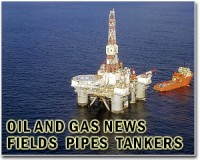 |
Cincinnati OH (SPX) Apr 13, 2011 The turmoil in oil-producing nations is triggering turmoil at home, as rising oil prices force Americans to pay more at the pump. Meanwhile, there's a growing industry that's promising jobs and access to cheaper energy resources on American soil, but it's not without its controversy. Deborah Kittner, a University of Cincinnati doctoral student in geography, presents, "What's the Fracking Problem? Extraction Industry's Neglect of the Locals in the Pennsylvania Marcellus Region," at the annual meeting of the Association of American Geographers. Kittner will be presenting April 14 at the meeting in Seattle. She is part of a large contingent of UC researchers to be presenting at the conference. Hydraulic fracturing, or fracking, involves using millions of gallons of water, sand and a chemical cocktail to break up organic-rich shale to release natural gas resources. Kittner's research examined the industry in Pennsylvania, known as the "sweet spot" for this resource, because of the abundance of natural gas. Pittsburgh has now outlawed fracking in its city limits as has Buffalo, N.Y., amid concerns that chemical leaks could contaminate groundwater, wells and other water resources. The EPA is now doing additional study on the relationship of hydraulic fracturing and drinking water and groundwater after congress stated its concern about the potential adverse impact that the process may have on water quality and public health. Kittner attended an EPA hearing and also interviewed people in the hydraulic fracturing industry. She says billions of dollars from domestic as well as international sources have been invested in the industry. The chemical cocktail used in the process is actually relatively small. The mixture is about 95-percent water, nearly five percent sand, and the rest chemical, yet, Kittner says some of those chemicals are known toxins and carcinogens, hence, the "not in my backyard" backlash from communities that can be prospects for drilling. The flow-back water from drilling is naturally a very salty brine, prone to bacterial growth, and potentially contaminated with heavy metals, Kittner says. In addition, there's the question of how to properly dispose of millions of gallons of contaminated water, as well as concerns about trucking it on winding, rural back roads. Based on her research, Kittner says that many in the industry are "working to be environmentally responsible, and become frustrated at companies that do otherwise." "I think that the study that the EPA is doing is going to be really helpful, and the industry - however reluctant to new regulations - is working with the EPA on this," Kittner says. Kittner has lived in Ft. Thomas, Ky., for two decades, but is originally from Warren, Pa. Her research took her to an EPA public meeting in Canonsburg, Pa., where she audio-taped 114 people presenting public statements of what they wanted the EPA study to examine. That study is expected to be completed in 2012 and will include an examination of what to do with millions of gallons of contaminated flow-back water.
Share This Article With Planet Earth
Related Links University of Cincinnati Powering The World in the 21st Century at Energy-Daily.com
 Transocean claims record sea depth for oil drilling
Transocean claims record sea depth for oil drillingZurich (AFP) April 12, 2011 Offshore oil drilling group Transocean claimed Tuesday that it had a set a world record for deep water drilling at an ocean depth of 3,107 metres (10,194 feet) off the coast of India. The depth was achieved by the ultra-deepwater drillship Dhirubhai Deepwater KG2, surpassing the previous record of 10,011 feet, also set by Transocean in 2003 in the Gulf of Mexico, the group said in a statemen ... read more |
|
| The content herein, unless otherwise known to be public domain, are Copyright 1995-2010 - SpaceDaily. AFP and UPI Wire Stories are copyright Agence France-Presse and United Press International. ESA Portal Reports are copyright European Space Agency. All NASA sourced material is public domain. Additional copyrights may apply in whole or part to other bona fide parties. Advertising does not imply endorsement,agreement or approval of any opinions, statements or information provided by SpaceDaily on any Web page published or hosted by SpaceDaily. Privacy Statement |